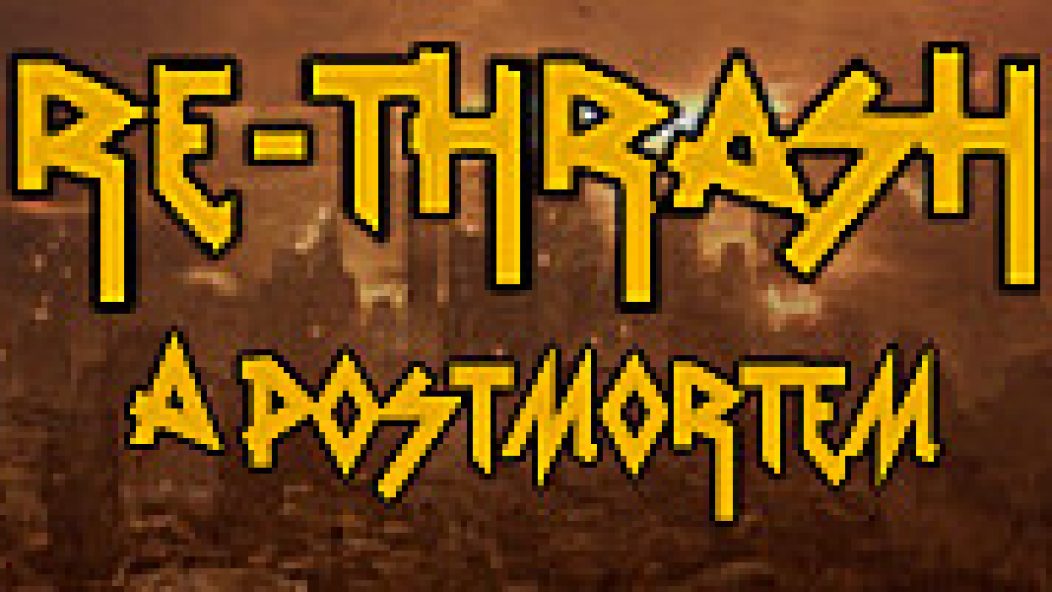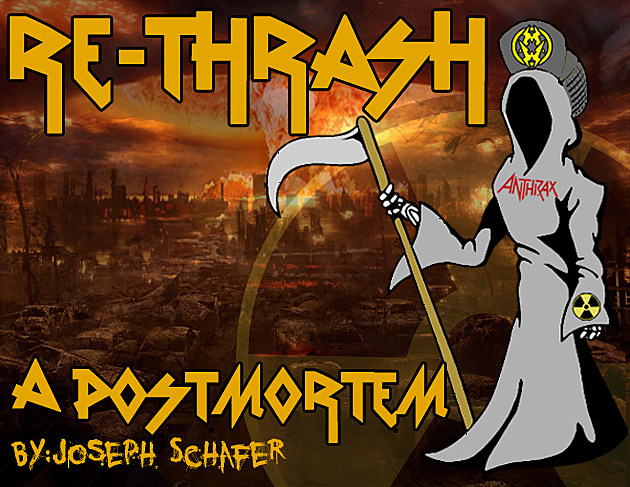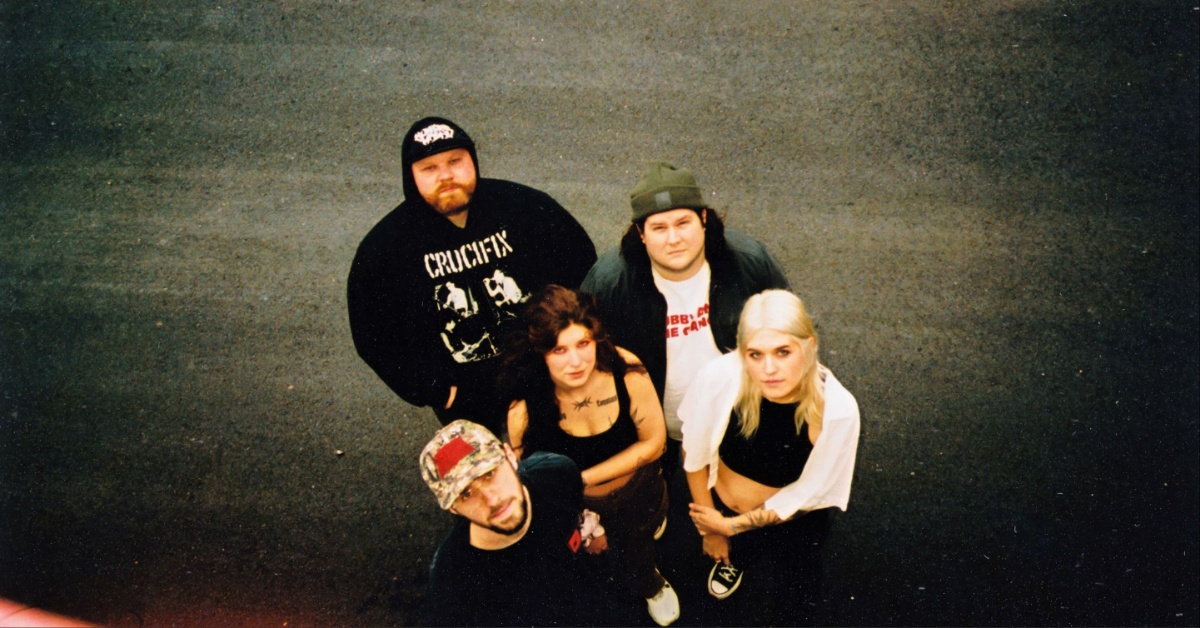
Re-thrash, a Postmortem

. . .
It appears safe at this point to pronounce the thrash revival officially dead. I can’t think of the last notable piece of work from that scene to remain on my iPod—either Havok’s Point of No Return or Vektor’s Outer Isolation. Both of those works dropped in 2011. That makes for one year with no signs of life, except for another release, like clockwork, from Municipal Waste.
As it happens, Municipal Waste’s first album, Waste ‘Em All, just had its tenth birthday. I like the band but don’t hold a torch for their debut—I prefer its successor, Hazardous Mutation. This will sound like a circular critique for an album more-or-less designed to provoke nostalgia, but Waste ‘Em All sounds dated. The record is about having fun, but it feels square. I felt the same way about last year’s The Fatal Feast. The most interesting things about that album—the synthesizer interludes and vague outer space theme—seemed added to the record simply so publicists would have something new to comment on.
It’s an inglorious endpoint for the sub genre that Digby Pearson believed would jump-start heavy metal out of a commercial rut. Admittedly, Pearson was not completely off-base: re-thrash has done some big business. After all, a re-thrash band, Black Tide, played the main stage on Ozzfest 2007 while Nile and Behemoth played the the smaller Jagermeister stage (to be fair, the band was slated to play the small stage as well, but were kicked off due to the band being under the legal drinking age, but they signed to Interscope so they still count as big money in my book.) More recently, Municipal Waste recorded a commercial for Vans shoes—how many bands get to endorse clothing?
The commercial shows off every cliché of the re-thrash movement: skateboards, urban decay, and of course high-top shoes. I half expected to see someone in a pizza delivery car, maybe a beat-up Iroc or Cutlass Supreme. The only element missing is beer, and Vans can’t have people beer bonging in a commercial aimed at teenage boys. All of these objects—none of which have anything to do with the music itself, or metal in general—make an aesthetic language that re-thrash spoke fluently right out of the gate.
Re-thrash’s aesthetic was probably the most marketable thing about it, and having a distinct visual style goes a long way toward getting outsiders interested in a kind of metal. It gives people a hook, a reason to work past any abrasiveness in the music itself. As silly as it is, corpse-paint probably kept black metal alive in America long enough for well-to-do urbanites to co-opt it. The thrasher look is an easier sell than the black metal one: can you imagine an alternate universe where Rimfrost make viral commercials for stage makeup or black leggings?
. . .
The music and the aesthetic sold a kind of fantasy nostalgia. Re-thrash didn’t just ape the sound of crossover thrash, it aped the pop culture that surrounded that music. Hell, “The Thing,” on Hazardous Mutation copies the horror film of the same name from 1980 verbatim. Perhaps the ‘aughts themselves had a bit of an ’80s obsession—both Transformers and “Reganomics” became cultural phenomena again.
But the re-thrashers dealt in escapism, not history. If everyone in Black Tide was 20 in 2007, there is no way the members themselves remember the ’80s. Their music recalls the ’80s the way those boys have been exposed to it: through the Teenage Mutant Ninja Turtles and SOD records. It cannot authentically recall the cultural zeitgeist of that time. History repeats itself, but not with precision. Fantasy’s been a part of metal since the beginning—I see no objective difference between romanticizing previous lives in the viking age or in the 1980s.
I can’t speak for the entirety of the international market, but I can relate precisely what I experienced on the ground level at my local record store, which specializes in metal and is something of a scene hub in Toledo, Ohio. At that establishment, directly after Hazardous Mutation was released, Heavy Artillery Records posters went on the walls, and the discussion was not about denim jackets, it was about metal consciously returning to something people could relate to.
Keep in mind this was 2003-4. The big records in the underground zeitgeist were things like Panopticon—openly marketed as “thinking-man’s metal”. The subtext in that statement: other metal does not encourage thought, maybe doesn’t even deserve much thought. Re-thrash dealt in the visceral. Its lyrics were superficial.
It was unthinking music.
Lich King – “Black Metal Sucks”
. . .
This was the golden age of over-the-top extreme metal. Necrophagist actually had new music at that time, while bands like Arsis made waves with shreddy debut records. Many of the most renowned European musicians of the ’90s were, at that time, cranking out symphonic black and death metal records with reckless abandon—for a brief bit there, Dimmu Borgir and Cradle of Filth were filling the void that Mudvayne left on MTV. Unlike those bands, re-thrash took minimalism to heart: minimal run times, minimal instrumentation.
Thrash had no compositional influence on cutting-edge metal at that time. The aforementioned bands share only a few things: down-tuning, and dense layers of arrangement. The core of thrash is in the way the guitar riffs alternate between low-end chugging and technical flourishes. Classic thrash is littered with percussive starts and stops—look in a Metallica or Slayer sheet music book, and you will find lots of half and even whole rests. The genre uses negative space to accentuate its own forward motion, and that compositional element was not en vogue in 2003.
. . .
Vindicator – “Dead in the Water”
. . .
The appeal of re-thrash was that, at a time when metal was perhaps at its most aristocratic, re-thrash was working-class in sound and aesthetic. It broke through the underground at an opportune time: VH1 had just launched its Americanized version of I Love the ’80s at the end of 2002, followed by the networks oft-maligned 100 Most Metal Moments in 2004. Pop culture was primed for a throwback to the denim and leather days directly when Hazardous Mutation dropped.
I call it an evolutionary accident that had profound repercussions, perhaps not in the way Pearson expected. While re-thrash produced a sudden glut of touring bands, not many of them sold particularly well, nor did they produce very many stone-cold classic records. What it did was bring thrash into the greater conversation in heavy metal, as well as give those older bands a much-needed shot in the arm. MTV-approved metalcore bands brought thrash into their vocabulary in a big way—Lamb of God tapped Alex Skolnik and Chris Poland for solos on 2004’s Ashes of the Wake. Two years later, Matt Heafy shot his career in the foot by indulging too much Metallica fandom on The Crusade. After years of mediocre records, or at least records commonly regarded as sub-par, Slayer and Megadeth started writing good records again. I daresay the newest material by Exodus and Testament is the very best of their respective careers.
. . .
Exmortus – “In Hatred’s Flame”
. . .
So why didn’t the young guns reap their own bounty? It certainly wasn’t a lack of interest or marketing. For once, by my reckoning the market actually functioned as the meritocracy that metal fans bemoan it for not being. Even as an avid fan of Heavy Artillery records and their ilk, I will be the first to admit that most of the re-thrash bands just made bad music.
The genre wrote itself into a corner. From the start, it never represented the totality of thrash, just the select spectrum of it that mimicked DRI, Nuclear Assault, and SOD. Re-thrash bands, on the whole, approached the genre as formalists: their albums were all as short as Reign in Blood or shorter, half an hour or less with very few exceptions. Some musicians use formalism as a creative exercise, but most re-thrash bands used concise songs as an excuse to play as quickly as possible. In so doing they lost the negative space that made the re-thrash movement invigorating in the first place.
That formalism also lost the creative spark that thrash, Californian and Teutonic, flaunted so heavily in the late ’80s. At its peak, thrash was not just crossing over, it was also producing arena rock ballads and progressive epics while mutating into death and black metal. Thrash moves forward, literally and figuratively. It was foolhardy to try and trap that lightning in a bottle by going backward in time.
. . .
Skeletonwitch – “Baptized in Flames”
. . .
In the end, the bands from that genre that mean the most to me did one of two things: they played the genre better than their heroes did (Municipal Waste, Havok, Vindicator), or they continue to move it forward. Few bands have done so much to stretch, bend, and break their genre conventions as Vektor. Even fewer bands care so little about sub genre distinctions as Skeletonwitch. Both of those bands see the past not so much for what it was or was not, but for what it might have been—and could still be. Most importantly, they write songs I want to hear over and over again in the course of their revisionist histories.
. . .










